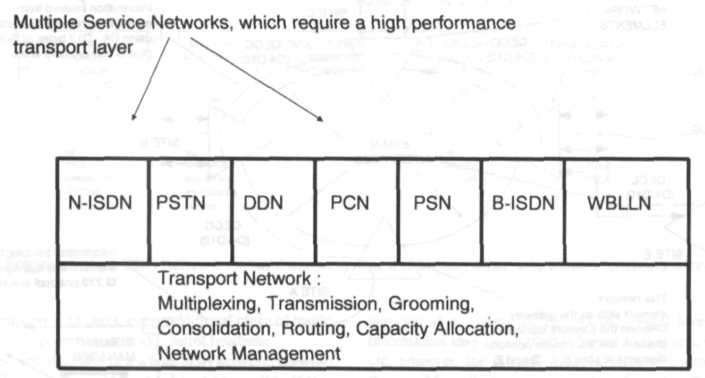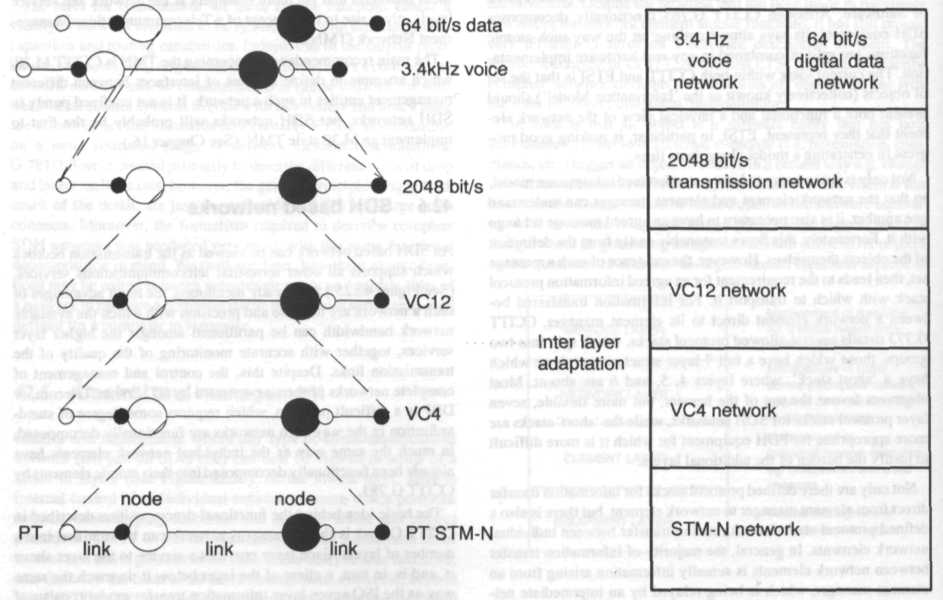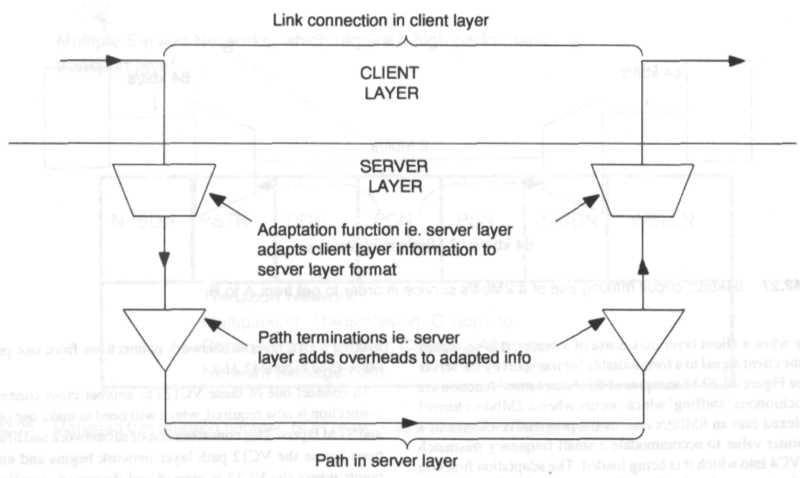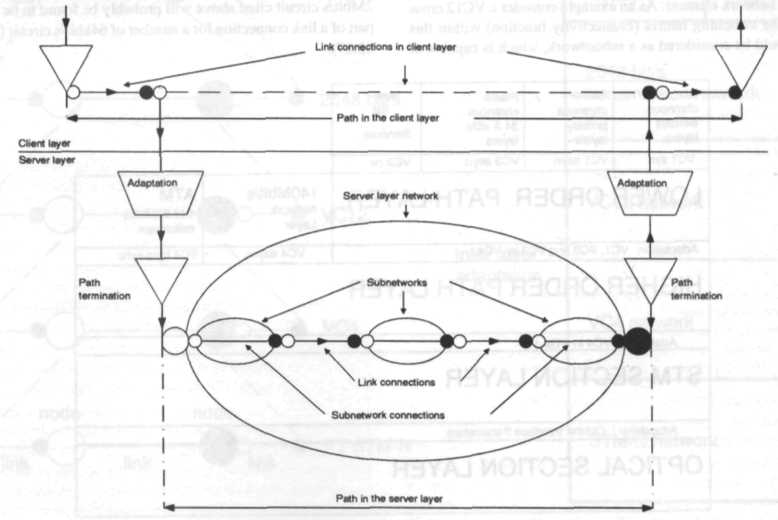
- •42 The Synchronous Digital Hierarchy (sdh)
- •42.1 Introduction
- •42.2 Pdh deficiencies
- •42.3 The basis of sdh
- •42.3.1 The concept of pointers
- •42.4 The sdh standards
- •42.4.1 Path OverHead information
- •42.4.2 Multiplexing of Virtual Containers
- •42.4.3 Channels and Tributary Unit Groups
- •42.4.4 Vc4 Into a Synchronous Transport Module
- •42.4.5 Further use of Pointers
- •42.4.6 Other sizes of vCs and payloads
- •42.4.7 Sonet and sdh
- •42.4.8 Nni Optical Interface standardisation
- •42.4.9 Sdh network elements
- •42.5 Control and management
- •42.6 Sdh based networks
- •42.6.1 Sdh network topologies
- •42.6.2 Deployment strategies
- •42.7 Impact of broadband standards
- •42.7.1 Frame Relay
- •42.7.2 Switched Multimegabit Data Service (smds)
- •42.7.3 Fibre Distributed Data Interface (fddi)
- •42.8 Future technologies
- •42.8.1 Integrated circuits
- •42.8.2 Optical interfaces
- •42.8.3 Optical amplifiers
- •42.8.4 Optical switching
- •42.8.5 Memory and processing power
- •42.9 Conclusion
42.6 Sdh based networks
An SDH based network can be viewed as the transmission bedrock which supports all other terrestrial telecommunications services. (See Figure 42.25.) As already mentioned, the main advantages of such a network are the ease and precision with which the available network bandwidth can be partitioned amongst the higher layer services, together with accurate monitoring of the quality of the transmission links. Despite this, the control and management of complete networks of the size operated by BT, France Telecom, or DBP is a difficult problem, which requires some degree of standardisation in the way such networks are functionally decomposed, in much the same way as the individual network elements have already been functionally decomposed into their atomic elements by CCITT G.783.
The basic idea behind the functional decomposition described in CCITT G.snal is that a transport network can be stratified into a number of layers. Each layer provides a service to the layer above it, and is, in turn, a client of the layer below it, in much the same way as the ISO seven layer information transfer model consists of layers which participate in client-server relationships with their vertical nearest neighbours. (See Figure 42.26.) This layering within an SDH network could be viewed as a subdivision of ISO layer 1. As an example of a non-SDH client-server relationship in a trans-port network, consider Figure 42.27, which shows a 64kbit/s circuit being a client of the 2Mbit/service layer i.e. the 2Mbit/s layer, which can be viewed as a 2Mbit/s network, transports the 64kbit/s circuit between its desired end points. In order to do this, the 2Mbit/s layer will probably call upon the services of the 8Mbit/s layer, and so on up to the 140Mbit/s layer. The SDH counterpart of this simple PDH example is slightly more complicated in that the transport layers are divided between those concerned with end to end networking (i.e. the Path Layers) and those concerned with transport between each pair of SDH network elements along the route (i.e. the SIM section layer). As an additional complication, there are two path layers, the lower order paths consisting of VC1 s, VC2s or VC3s, and the higher order paths, which are VC4s in CEPT countries, hut could also be VC3s. (See Figure 42.28.)

Figure 42.25 Managed transmission network; SDH network as a bearer for other services

Figure 42.26 Layering and client server relationships between the layers of an SDH network

Figure 42.27 64kbit/s circuit making use of a 2Mbit/s service in order to get from A to B
Usually when a client layer makes use of a server, it is necessary to adapt the client signal to a form suitable for transport by the server layer. (See Figure 42.29.) Examples of this 'adaptation' function are the plesiochronous 'stuffing' which occurs when a 2Mbit/s channel is multiplexed into an 8Mbit/s one, or the progressive change in a VC12 pointer value to accommodate a small frequency mismatch with the VC4 into which it is being loaded. The adaptation function is only one of the network atomic functions that have been described in G.snal, and it is indeed fortunate that G.snal has been developed in full recognition of the contents of G.782/783 because many of the equipment and network atomic functions are identical.
G.snal, not only describes a series of vertical client-server relationships for an SDH transport network, it also gives a structure to each of the individual layers. Each layer can he viewed as a network in its own right, which can he partitioned into a series of subnetworks. (See Figure 42.30.) These subnetworks are connected together by "link connections', and can, if necessary, be further subdivided into yet smaller subnetworks. The logical place to stop this process is where a whole subnetwork is completely contained within one network element. As an example consider a VC12 cross connect. The switching matrix (connectivity function) within this element could be considered as a subnetwork, which is capable of making VC12 layer subnetwork connections from one port to another. (See Figure 42.31.)
To connect one of these VC12s to another cross connect, a link connection is now required, which will need to make use of the VC4 and STM layers. This concatenation of subnetwork and link connections across the VC12 path layer network begins and ends at the points where the VC12 is created and destroyed, namely the path termination points. It is at these points that the VCI2 POH is added or removed, exposing only the C12 Synchronous Container. This same path termination function is recognised in both G.783 and G.snal and it is located immediately next to the adaptation function described above. On the assumption that the C12 in question is carrying a 2Mbit/s circuit, then the combination of adaptation functions, termination functions and the chain of subnetwork and link connections in the VC12 layer have succeeded in transporting this 2Mbit/s circuit between the two end points of a single 2Mbit/s link connection. (See Figure 42.31.) From this point, the above analysis can now be repeated in the 2Mbit/s layer, where the particular 2Mbit/s circuit cited above will probably he found to be serving as part of a link connection for a number of 64kbit/s circuit (see Figure 42.27).
This formal description of an SDH network opens up the prospect of real control and management of large networks consisting of network elements from several manufacturers. The pairing of path termination functions on opposite sides of a network, together with a similar operation on the same functions in the STM layer, allows a PTO to accurately monitor the service which the SDH network is delivering, and to pin-point those network elements responsible for any poor performance. Beyond that, the SDH network model greatly facilitates management of the all important traffic flexibility points i.e. those subnetworks which consist of an electronically controllable connectivity function.

Figure 42.28 Layering in an SDH transport network

Figure 42.29 Handling a link connection in a client layer by a path in a server layer

Figure 42.30 Partitioning of a transport layer network into a series of subnetworks
1. Learn the following technical words and word-combinations:
42.4.5
1. |
a hardware integrated circuit |
схема аппаратных средств |
2. |
to decompose |
разлагать, расщеплять |
3. |
management information |
управленческая информация, административная информация |
42.4.6
4. |
decomposition |
декомпозиция, разбиение |
5. |
stratify |
расслаиваться, наслаиваться |
6. |
layering |
наслаивание, расслоение, иерархическое представление |
7. |
end point |
конечная точка |
8. |
link connection |
связь звеньев |
9. |
switching matrix |
коммутационная (переключательная) матрица, матричный переключатель |
10. |
concatenation |
последовательное соединение, связывание, сцепление |
11. |
pairing |
парная крутка, скручивание парами |
12. |
to pinpoint |
1.точно определять местонахождение; 2.находить неисправности |
Exercise 2 Read the text 42.5- 42.6.
Exercise 3 Find the Russian equivalents for the following English technical word- combinations:
1. |
the internal network element control system |
|
2. |
the management hierarchy |
|
3. |
the network element atomic functions |
|
4. |
the rules of object oriented programming |
|
5. |
an agreed standard set of SDH objects |
|
6. |
a standardized information model |
|
7. |
an agreed message set |
|
8. |
an agreed information protocol stack |
|
9. |
an intermediate network element |
|
10. |
a Telecommunications Management Network |
|
11. |
different management entities |
|
12. |
the ISO seven layer information transfer model |
|
13. |
a non-SDH client-server relationship |
|
14. |
the path termination point |
|
15. |
the chain of subnetwork and link connections |
|
16. |
the pairing of path termination functions |
|
Exercise 4
Find the English equivalents for the following Russian technical word- combinations:
1. |
регулирование и управление |
|
2. |
внутренний контроль отдельных элементов(звеньев) цепи |
|
3. |
взаимосвязь трафика |
|
4. |
объект программного обеспечения |
|
5. |
реализация аппаратных средств (аппаратного обеспечения) |
|
6. |
G.773 детализирует несколько разрешенных протокольных стеков |
|
7. |
точный мониторинг качества линий передачи |
|
8. |
функция адаптации |
|
9. |
функция связности |
|
10. |
тракты низшего порядка |
|
11. |
наземные телекоммуникационные услуги |
|
12. |
доступная полоса пропускания сети |
|
13. |
передача информации |
|
14. |
понимание сетевой топологии |
|
Exercise 5
Make up 4-5 questions on part 42.5 “Control and Management” and be able to ask your group-mates to answer them.
Exercise 6
Answer the following questions on part 42.6:
1. What are the main advantages of SDH based network?
2. What is the basic idea behind the functional decomposition described in CCITT G.sna 1?
3.How could layering within an SDH be viewed?
4.When does the plesiochronous “stuffing” occur?
5. What is the role of G.sna 1? How can each layer be viewed?
Exercise 7
a) Translate into Russian in writing part 42.5 paragraph 1.
b) Translate into Russian in writing part 42.5 paragraphs 2 (up to “The idea is that…”)
Exercise 8
Make a short report on SDH based networks (part 42.6)
Part 6 (42.6.1-42.6.2)
2. SDH network topologies
1. Deployment strategies
